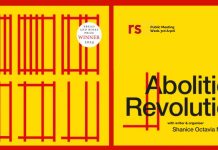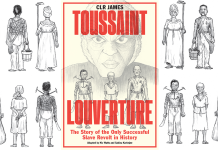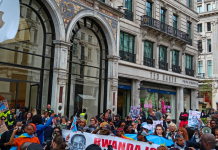Estelle Cooch reports on a lively launch of Assata Shakur’s autobiography at the recently opened Black Cultural Archives in Brixton
It may be forty years since Assata Shakur, still the FBI’s most wanted woman, went on the run and sought asylum in Cuba, but the debates and controversy that surrounds her arrest doesn’t look to be going away anytime soon.
Assata was charged in 1973 for the murder of state trooper Werner Foerster at the side of a New Jersey toll road at a quarter past midnight. Convicted to life in prison she miraculously escaped and last year the FBI placed the 66 year old on its list of top ten wanted terrorists.
Forty years on and over a hundred people packed into the recently opened Black Cultural Archives in Brixton to hear a panel of speakers, spoken word artists and musicians discuss Assata’s life. The evening was hosted by Zed Books to launch the republishing of Assata’s autobiography and was compered by rapper Akala.
As I arrived what was immediately noticeable was the number of young people. Overflowing into the courtyard of the BCA, keen locals were mesmerised by the drummers (including the famous Jamaican record producer Lloyd Coxsone) that kicked off the event.
With the room full to the rafters the drumming was paused for a minutes silence for Michael Brown, the black man killed in Ferguson, Missouri that has sparked riots in the US.

Following this was a call to the audience to shout names of other famous black people from “I- story because we don’t call it history”, the drummer said. Names such as Patrice Lumumba, Mary Seacole, Steve Biko, Harriet Tubman, Maya Angelou, James Baldwin and Stuart Hall echoed out from the crowd filling the room with noise and what the drummer called “polyrhythmic effect”.
The audience joined in for Bob Marley’s Get Up Stand Up which slowly morphed into the band’s own track Standing at the Crossroads.
[wpvideo VE3Q7P83]
At this point lively compere and rapper Akala launched into part of his famous Fire in the Booth Part Two which in the context of the rise of ISIS in Iraq played a worthwhile role in reminding us who was committing crime there first:
“We all commit crime, Simply by paying tax
Cos’ we then go and tickle the people in Iraq
And ask them so politely for all their minerals we extract
We blew children’s heads off, Set fire to backs
We’re a gangsta nation get down or you get clapped, so
When you see the yout’ running around on the road with heaters
Don’t be surprised, they’re just copying their leaders
Long as the wars stay in places that are brown and poor
We can all pretend to be abhorred – But we applaud”
At this point the musical intro to the evening came to an end and the mic was passed over to Kings College lecturer Daniel Matlin and writer and performer Zena Edwards who charted Assata’s story alongside extracts from her book.

Her story, although unique in some aspects, is also the story of a whole generation of African-American activists who found themselves pursued by the state.
Unfinished business
The Black Power movement of the late 1960s and early 1970s was concerned with the unfinished business of the Civil Rights movement. Yes, black people could now sit next to white people on buses. Yes they could vote in Mississippi or Alabama, but across the north of America black people had been doing this for years and were still second class citizens.
Assata was born JoAnne Byron in Queens, New York in 1947. As she grew up, new protests following the murders of Martin Luther King and Malcolm X were beginning to reshape the black movement. Out of this came the Black Power movement which responded to some of the blind spots that had existed within civil rights. Black Power tried to address the economic disparities that still existed between black and white. It also brought civil rights to the heart of the political issue of the day; Vietnam.
Black people were being disproportionately killed in Vietnam prompting writer James Baldwin’s question “Do I want to be integrated into a burning house?” to ring in the ears of every young black activist.
With this in mind in 1970 Assata joined the Black Panther Party’s Survival Programme that provided breakfasts and basic services to impoverished families in Harlem.

During this period she began to interrogate her roots more closely:
“The name JoAnne began to irk my nerves. I had changed a lot and moved to a different beat. I didn’t feel like no JoAnne, or no Negro, or no amerikan. I felt like an African woman. My mind, heart, and soul had gone back to Africa but my name was still stranded in Europe somewhere.”
And so it was that JoAnne, changed her name to Assata – or “she who struggles”.
This turning point in Assata’s life coincided with a turning point in the movement. Amidst the urban unrest of summer 1967, the FBI’s counter-intelligence program (COINTELPRO) which had been used to hunt down communists in the 1950s was redirected against the burgeoning black movement.
“Neutralising” black activists
FBI director J. Edgar Hoover instructed FBI offices to “disrupt, misdirect, discredit, or otherwise neutralize the activities of black nationalist hate type organizations”.
This “neutralisation” of black activists was a fitting euphemism for what happened. Prominent leaders like Bobby Seale and Huey Newton were arrested, while hundreds of others were tried on trumped up charges. In 1969 Fred Hampton, deputy chair of the Illinois chapter of the Black Panthers, was killed in a raid as he lay asleep in his bed in Chicago.

As the FBI’s strategy of neutralising black activists was ratcheted up, those that remained were forced into hiding or into the underground networks. By 1973 Assata had joined one such group – the Black Liberation Army.
The BLA gained strength as the Black Panthers declined. It was, according to its manifesto, “anti-capitalist, anti-racist, anti-imperialist and anti-sexist”. It stated “In order to abolish our systems of oppression, we must utilize the science of class struggle, develop this science as it relates to our unique national condition.”
The police were seen as legitimate targets for the BLA, but there is little evidence that Werner Foerster, whom Assata was accused of killing, was one such target.
The day to change her life forever
On 2 May 1973 as she was driving with two other BLA members through New Jersey, Assata’s car was pulled over under the pretence of faulty rear lights. Within minutes Zayn Shakur, a fellow BLA member, and state trooper Foerster were dead. Assata and friend Sundiata Acoli, sporting gunshot wounds, were arrested. The incident was to change her life forever.
To this day the events on the side of that road in New Jersey remain much of a mystery. In Assata’s trial it emerged that there was no forensic evidence to suggest she touched any of the weapons at the scene. Five members of the all-white jury that convicted her were either friends or relatives of Jersey state troopers. On entering prison she was kept alongside members of the “Aryan Sisterhood” – a neo-Nazi group known for its attacks on black activists.
But Assata’s remarkable story did not end with her languishing in jail. The reason she remains amongst the FBI’s “top ten terrorists” today is because in 1979 three members of the BLA posing as visitors sprung her from prison. When news of her escape got out posters were plastered around Brooklyn: “Assata is welcome here”. In 1984 she resurfaced in Cuba where she still lives today.
Assata’s story is a unique one, but as lecturer Daniel Matlin made clear had she not escaped her story would be far more predictable. Sundiata Acoli who was in the car with her on that fateful day remains in prison, now 77 years old. While, Russell Shoatz, a BLA member convicted of murdering a police officer has been held in solitary confinement since 1991 in a 7-by-12 foot cell, always illuminated by lights, for 23 hours per day.
The penalty for white police officers, however, who shoot black people dead, whether it be New Jersey 1973 or Ferguson 2014, seems to have changed little.
Zena Edwards and Daniel Matlin painted an exquisite picture of Assata’s struggle. There were moments in Edwards’ readings where you could hear a pin drop, such was the shock from the audience, despite many being familiar with the story.
[wpvideo K41ru3T9]
This was complemented by Esther Stanford-Xosei’s discussion of the legal implications of Assata’s case on the fight for reparations.
Poignantly in the light of the events in Ferguson she noted “Before there can be repair there has to be stopping the harm itself. This is what we call ‘cessation of violation’ in legal terms.”
Xosei fascinatingly drew out what revolution meant to Assata:
“For Assata revolutionary war is not synonymous with violence. She says it begins with a revolution in consciousness. The power of the people is stronger than any revolution…For Assata true reparations would be structural change and transformation… ultimately leading to an end to capitalism itself.”
Xosei explained how it was this legacy that has sustained the FBI’s obsession with Assata. She is not as a 66 year old woman any physical threat, but by keeping a $2million bounty on her head it remains a warning to activists today.
When Xosei finished the microphone was passed back to Akala and the two previous speakers returned to the stage. This was never going to be the kind of discussion that had you checking your watch.
Even calling the to-ing and fro-ing from floor to panel and back again a discussion seems a bit unfair. What followed was an hour long conversation, at times argument, between panel members and audience members simultaneously. The first couple of questions were biggies. Is Palestine a black liberation struggle? And when did it become uncool to be a revolutionary?
Is Palestine a black struggle?
Akala, who has been active in the Palestine movement for several years now, was keen to jump in:
“The struggle of the Palestinians is a black struggle in so far as it is about a revolutionary struggle, it is about injustice. But I don’t always see those on Palestine demonstrations turning out for the Congo and wagwan with the treatment of black people in Saudi Arabia? It’s got to be a two way street.”
At this point Zena Edwards cocked her head and looking thoughtful, interjected:
“I’m interested in black and what black means. I was in Chicago last month and a woman said to me ‘I’m not African American, I’m black.’ Now black is a problem for me. Some people I speak to in Africa say they never were black until they came to Europe. It’s interesting that Akala makes that distinction between brown and black. When are you brown and when are you black? Sorry, but at this point ‘black’ becomes almost this political psychic space which you occupy.”
In an attempt to either defend his point or clarify it, Akala noted that there are differences between the treatment of black and brown people and consequently we shouldn’t ignore them. At this Zena retorted “So we are literally talking about the concentration of melanin?”

Kings College lecturer Daniel Matlin had an interesting take on the question. For him:
“The important thing is that we call injustice by its name. If that involves people calling it a black liberation struggle then that’s fine by me. But I might call it a Jewish liberation struggle as a British Jew.”
At this Akala disagreed saying “But we have to call white supremacy by its name”, prompting a shout from an audience member: “What about the systematic oppression of women? Where does that fit in then?” and a commitment to return to that question after the panel had finished their responses.
When did being a revolutionary become uncool?
Esther Stanford-Xosei took on the question of being uncool with a useful qualifier. “I’m not sure it was ever cool to be a revolutionary,” she said. “Let’s not forget there were many in our own community who didn’t and don’t support revolution and did everything in their power to suppress those who fought for it.”
In response to this came another shout from the audience that prompted nods of agreement -“Revolutionaries only ever become cool when they’re dead!”
The next round of questions took the discussion along a different path. The first question, “why is Assata still alive” provoked several responses from the audience. One woman said “because she’s in Cuba”, while the man next to me looked confused at such a simple question and muttered “Obviously because she’s a G.”
The second question, ironically, was probably the most divisive one of the evening (bar perhaps a bizarre interlude on whether or not Daniel Matlin was right to call the Cuban government a regime. For what it’s worth – I think he was right to).The question “How do we unify the struggles of race, class and gender?” is one of the most talked about topics in the left today with various solutions – some nuanced, some complex, some just plain crude – proffered up all the time.
[wpvideo 42KeNh78]
Erring on the side of caution, Zena Edwards suggested that we need to listen more to others as they describe their differing experiences of the world, but concluded that “we do need to remember that race is a social construct.”
Daniel Matlin agreed, “Race is an idea – an idea rooted in capitalism and racism. It is an idea that has sowed division and oppression, but on the other hand it has also brought people together in struggle”.
Eventually several of the younger audience members shouted out “intersectionality”, sounding slightly exasperated that it hadn’t already been mentioned. One woman explained “If you’re a feminist you have to understand that you have a particular experience. If you’re a working class woman you have a certain experience. You have to represent yourself because no one else will, but you also have to understand that we might have different paths but we have to be going to the same destination.”
At this one man at the back of the room said in a raised voice “I have a problem with feminism. What about misandry? Women hating men?”
Quicker than you could say “awkward…” the woman next to him replied:
“What you talking about? Women can’t be sexist to men, just as black people can’t be racist to white people. It’s systematic and structural oppression.” This satisfied the crowd and the panel were brought back in to sum up.
After another divergence of opinion between Zena and Akala on black history the debate was over, the drinks were poured and Public Enemy came on through the soundsystems outside.
I was lucky enough to grab Paul Reid, the current director of the Black Cultural Archives at the end to ask him what he thought of the event:
“This was an absolutely tremendous event for the launch of Assata’s autobiography. I’m only sorry she wasn’t here or we couldn’t do a video link up to Cuba.
It’s also been a tremendous turn out with such a young age group. I have to really thank Akala and Zena, who call upon a certain audience, for that. People interested in finding out more about the BCA should check out our pedal-powered outdoor cinema showing short films about the black diaspora on 29 August.”
As the audience dispersed into Brixton at some time past 10pm I was reminded of a line from one of my favourite films, In the Heat of the Night. Set in Mississippi in 1965 at the peak of the civil rights movement Detective Virgil Tibbs, played by black actor Sidney Poitier, is forced to unite with the local white police force to solve a murder.

At one point Poitier confronts the black owner of a small store who does backstreet abortions on the side and reminds her “Don’t make me have to send you to jail… There’s white time in jail and there’s colored time in jail. The worst kind of time you can do is colored time.” (Here at 3.28)
Although many former Panthers now languish in American jails, while others lie dead, it was clear that from Ferguson to Brixton, the issues that confronted those activists in the late 1960s are very much alive and kicking today.
You can buy Assata’s biography for £8.99 from Zed Books here. and check out the upcoming events at the Black Cultural Archives here.




















